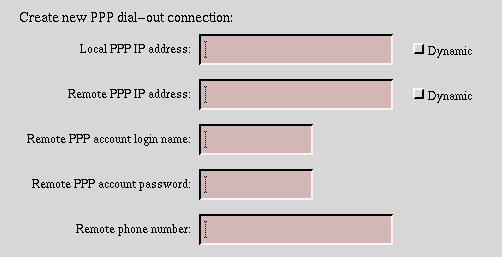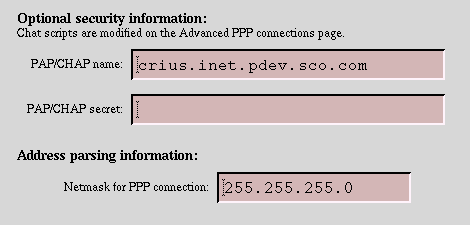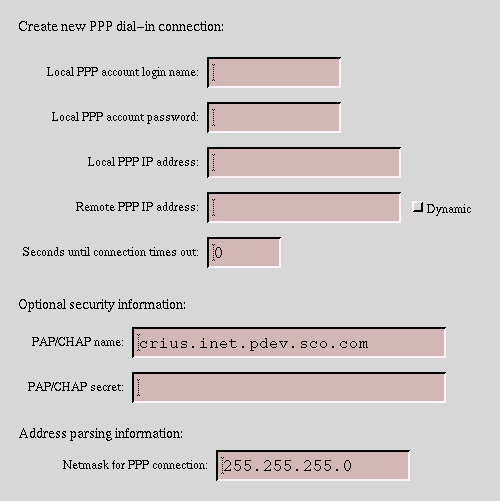
|
|
If you plan to use a modem to connect to the Internet, you must configure an outbound PPP connection. To do this, you should have a PPP account with an Internet Service Provider (ISP). Your ISP will provide you with a telephone number to dial as well as other important information necessary to configure your link.
See ``Adding modems'' for general information about installing and configuring modems.
At a minimum, you need the following information to create a PPP connection:
If your ISP does not provide you with these IP addresses, then the addresses are assigned to you dynamically each time you dial in, and you do not need to know them. However, you must enter the IP addresses when you create the link (the addresses you enter will be replaced with the correct ones when you dial in). If your ISP does not provide you with initial addresses to use, use 127.0.0.2 for the local site and 127.0.0.3 for the remote site.
You might also need to know the following additional security information:
See also:
Once you have the information described in ``Using a modem to connect to the Internet'', you are ready to create a PPP connection. The information required is the same whether you are connecting to an ISP or if you simply want to dial in to another system.
The Internet Manager page for configuring an outbound PPP connection contains three sections.

Creating a new PPP dial-out connection
If your ISP or network administrator has given you IP addresses for your system and/or the remote system, enter them here; otherwise, choose default addresses and select Dynamic to indicate that IP addresses are to be reassigned dynamically. You must also enter your login name and password. If you are using a modem to make the connection, enter the remote phone number.

Modem and connection type
If you are using a modem to make the connection, select the modem type from the list provided. If your modem does not appear in the list, try one of the generic settings.
You also need to specify whether the line should stay up all the time, or if it should only come up automatically when packets need to be routed across the link. Do this by setting how many seconds the connection needs to be idle before it times out and hangs up. If you are using a part-time connection, the correct timeout value depends on the cost of your phone connection; for many situations, a value of 120 is reasonable. Entering a value of zero (the default) causes the line to stay up continuously. You can also instruct the system to dial the connection every time the system boots.

Optional information
You might also want to specify certain optional parameters. If your ISP or network administrator gives you PAP/CHAP authentication information, enter it here. Finally, you must verify the netmask, which is necessary for the system to properly route packets. A default value of 255.255.255.0 is appropriate for a class C network and is commonly used; you should change it only if your ISP or network administrator instructs you to do so.
The Internet Manager does not support the creation of a dial-in Morning Star PPP server unless you have an active Ethernet connection. Without Ethernet, the only choice in the Internet Manager for a first connection is dial-out.
In most cases, a LAN connection is desirable for Morning Star PPP servers. If you require a LAN connection for your server, enable it using the Network Configuration Manager before configuring PPP with the Internet Manager. For more information, see ``Configuring network connections''.
If you do not need LAN access for your Morning Star
PPP
server, you can work around the Ethernet requirement by creating
a non-functional Ethernet configuration file. To do so, enter:
touch /usr/internet/admin/.initdone
Then, restart the ncsa_httpd daemon:
/etc/rc2.d/S91mana http stop
/etc/rc2.d/S91mana http start
Finally, configure dial-in Morning Star PPP connections with the Internet Manager. The .initdone file will be overwritten if you add LAN connections later.
Configuring an inbound PPP connection is similar to creating an outbound connection.

Creating an inbound PPP connection
You must set the account name and password for each PPP connection, typically one per user. The user account is created for you, using system account defaults (except for the shell, which is specifically for PPP users). You also must specify the IP address used on your system's side of the connection. You can specify that a fixed IP address be used by the remote system each time it connects. If you select the Dynamic checkbox, the system uses the IP address given to it by the remote side of the connection during link negotiation. You must specify a default IP address even if you select the Dynamic checkbox.
To configure the system to select an IP address for inbound PPP connections automatically from a pool of addresses, first define the pool, then activate IP address pool selection:
On each line, include three fields: local IP address, remote IP address that may connect to the local address, and netmask. For example:
154.224.87.98 145.127.182.124 255.255.255.0
When the /usr/lib/mstppp/IPPool file exists, the inbound PPP connection configuration page displays a ``Use IP Address Pool'' checkbox. If you check this box, an IP address for the inbound connection will be chosen from available addresses listed in the IPPool file.
Make sure dynamic reassignment of IP addresses is enabled on the system dialing in. (If the dialing system is an SCO OpenServer system with Internet Services enabled, select the ``Dynamic'' checkbox when configuring the dial-out connection.)
Enter the number of seconds you want to allow the link to be idle before the system drops the connection. If you enter zero, the system will not drop the connection because it is idle; if you want a part-time connection, enter the timeout period (120 seconds is a reasonable value).
If you require that the remote system authenticate itself using PAP/CHAP, enter the PAP/CHAP name and secret. Finally, enter the appropriate netmask to use for this link; a value of 255.255.255.0 is appropriate for class C networks and is commonly used. If your network uses a different netmask, enter it here.
Once you click on OK, the PPP link is ready to use, and a remote system should be able to connect almost immediately.
While running the Internet Manager for the first time, you have the choice of testing your connection to the Internet. If your Internet connection is through a modem, there is a chance that while you have PPP and the modem properly configured, the connection will time out. If this occurs, it is best to try the connection test twice before assuming that there is a problem.
Note that Testing your Internet connection is a simple ping command. It is possible that this command may fail even though your Internet connection is valid. Network firewalls may prevent this command from succeeding. If this test fails, we recommend that you evaluate other connections to the Internet, such as http or ftp, before calling for technical assistance.
Even though the configuration of a PPP connection appears to be simple, problems often arise. These are most often the result of making the wrong modem selection for the modem you are using, or of the two sides of the connection not agreeing on all the necessary parameters.
Determine that the configurations for both sides of the connection are consistent. For example, they must agree on the account name and password, and the netmask for the connection must agree. Check your IP addresses to make sure they are consistent. If this is an incoming connection, be sure that you do not make the IP address for a system as specified on both sides of the connection dynamic, as neither system will tell the other which IP address to use.
It is often useful to watch what the PPP daemon is doing on your system when it attempts to make the connection:
where processID is the second column of the output from the grep command.
Particular things to watch for are account names and passwords that are
incorrect. Also, if one end of the connection is expecting a string to be sent
by the other (for example, login:) and the other side sends
something else (for example, username:), this is a problem. If
you have such a problem, you can
use the Internet Manager to modify the chat script by
clicking on the Net button on the Internet Services page, then
clicking on the PPP Connections button. If more
than one dial-out connection is configured, select
the dial-out PPP connection you are debugging,
then click on the Advanced button.
The login chat script can be modified from that page.
Alternatively, you can modify the
/usr/lib/mstppp/Systems file, where the chat script is stored. The
format of each of the configuration files is described in the corresponding
man page:
ppp.Accounts(MST_PPP),
ppp.Auth(MST_PPP),
ppp.Devices(MST_PPP),
ppp.Dialers(MST_PPP),
or ppp.Systems(MST_PPP).
If you have a complicated chat script, the
Internet Manager might not be
able to configure the connection
after the chat script is modified.